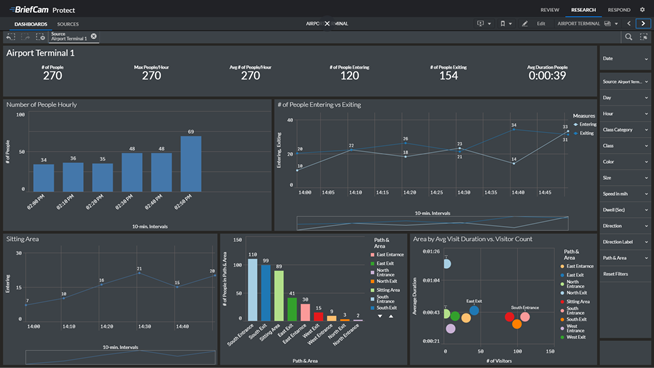6 Real Advantages of Video Analytics Automation

The Benefits of Automation
Today, automation tools drive various business processes, with machines completing tasks that once required manual human intervention. Automation saves time, money and resources and – because manual processes are prone to human error – it increases accuracy and precision. In many cases, automated activities can be pre-scheduled for optimal times to drive improved operational efficiency.
Overcoming the Video Processing Challenges with Automation
As an example, some organizations have deployed video intelligence software, which aggregates and analyzes the content of video surveillance footage. A large network of video cameras typically gathers a substantial amount of footage on an hourly or daily basis. Before operators can review such video footage, the video data must be processed; i.e., Deep Learning techniques must be applied to detect, identify and classify objects and behaviors that appear in video, and then index and store them so they can be leveraged for data insights. In terms of computing resources, a video processing server consumes significant processing resources, including both CPU and the GPU memory, which means that it can sometimes impact other video analysis computing activities. Therefore, users must strategically decide when to initiate video processing, to ensure sufficient computing resources are available for running analytic activity. Automation can help users strike a balance, ensuring that video data is pre-processed and available for analysis and that computing resources are available for on-demand analysis and processing, based on the operator’s requirements.
The Advantages of Video Content Analysis Automation
Video intelligence software users can leverage a comprehensive range of analytics to make video searchable, actionable and quantifiable. From indexing video metadata to drive rapid video review and search, to triggering real-time video object-based alerts and visualizing the metadata aggregated over time into BI dashboards and reports, video processing can be scheduled to support this broad range of activity. A user might configure specific alerting rules that are automatically activated based on the time of day, week or even year. By automating video processing to support the different alerting needs, video surveillance operators can monitor video effectively, proactively respond to dynamic situations and improve overall security.
Examples of automation applications abound, but here are some of the benefits of automating video processing across all its use cases:
Accelerate Investigations
By automating video processing, CCTV video evidence can be processed in advance and ready by the time the investigators have a reason to review it. The investigators’ efforts can be streamlined by proactively automating video processing instead of reactively processing video when an incident occurs. For example, this capability is very powerful for mass event organizers or convention center security teams. Although they can’t predict what will occur, they know that incidents are likely to happen. By proactively scheduling video processing, event security can ensure faster access to searchable video evidence and start investigating more quickly after an incident takes place.
Dynamically Attain Situational Awareness
When scheduling automated video processing, operators proactively process the video because they know they will likely need to search through the video, and they want the video data ready when they need it. For some organizations, only video captured at certain times of day or in certain spaces is important for reviewing and searching. For example, in a retail environment if security wants to be able to review activity in the store during hours when the store is closed, they can pre-define that video captured from 10 p.m. to 9 a.m. is processed automatically every day so, the next day, the operator can rapidly review or search for objects in video.
Proactively Drive Real-Time Alerting
Many organizations leverage video intelligence software for the real-time alerting capabilities, but not all alerting logic is relevant for all scenarios. In a retail environment, the types of alerts that may be important during peak shopping times are likely different than those necessary for everyday shopper traffic. For example, on Black Friday a retail store might pre-schedule alerts optimized for expected challenges and activity to increase situational awareness and keep their fingers on the pulse of events developing. Whereas a store might deploy count-based alerts for everyday activity, they might define and schedule processing to support special count-based alerts for Black Friday, when high traffic is expected. This way, alerts can be triggered based on crowd density and dwelling to ensure the physical safety of the shoppers and property in the store.
Similarly, for retailers that configure alerts for everyday activity, it’s not always necessary for the processing to be continuous. Retailers can optimize video processing for powering real-time alerts and automate video processing for other analytic activities for relevant time periods (for instance, operators can schedule the video processing while the store is closed).
Schedule Business Intelligence Dashboards
In addition, when video is aggregated over time it can be used to populate business intelligence reports, dashboards, and heatmaps that give all the business groups within the organization insights into everyday activity, trends and patterns. Businesses that use video analysis regularly can also automate the creation of these dashboards, specifying the recording times, locations, and sources that need to be processed to populate specific reports. It can be used to populate dashboards to track activity during specific hours where there is activity, rather than during inactive hours.
The automated processing of video content offers several benefits, ranging from reduced impact on computing resources to improved efficiencies and accuracy. It is especially important that it be a customizable feature, so that every organization can apply it according to its operational and security needs.
More on Video Content Analytics.